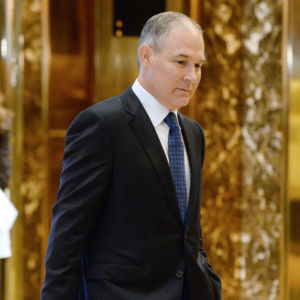Editor’s Note: For an alternative viewpoint, please see: Counterpoint: Gutting EPA’s Budget Would Endanger the Health of Millions of Americans
Whatever the size or scope of the Environmental Protection Agency following President Trump’s proposed agency reforms, there are reasons to be hopeful about the future of the environment in the United States.
Many environmentalists are quick to point to the landmark Clean Air Act of 1970 as the beginning of environmental improvement in America. Studies, however, have shown that innovation and market forces led to improvements as much as 40 years before the act went into effect.
These same forces of environmental improvement are still in effect today, leading to innovative energy alternatives, localized voluntary environmental protections, and state-led cooperative conservation efforts.
For the past decade, much of the EPA’s efforts have focused on reducing carbon- dioxide emissions from energy production to fight climate change. Most people don’t realize, however, that U.S. emissions of carbon dioxide due to energy production actually fell by 12 percent from 2005 to 2015. According to the U.S. Energy Information Administration, most of that decline was due to the “decreased use of coal and the increased use of natural gas for electricity generation.”
The shift from coal to natural gas has been driven more by market forces like innovation and competition than by EPA regulations. A study by professors at Case Western Reserve University found that the availability of cheap shale gas has been the primary force in reducing U.S. coal production. The study found that “while we can’t say that the EPA rules have no impact … the data say the EPA rules have not been the driving force.” President Trump’s energy plan calls for unlocking oil and gas production on federal lands, which would likely lead to further increases in natural gas production.
All of this is good news for the environment, since natural gas produces about half as much carbon dioxide as coal, per unit of energy generated. As the shale revolution continues to expand U.S. production of natural gas through hydraulic fracturing and horizontal drilling, U.S. emissions are likely to continue to decrease.
There is also reason to be hopeful that environmental issues like conservation will not be abandoned during the Trump administration. In fact, reducing the regulatory burdens that stem from top-down EPA enforcement would free up more resources that individuals and organizations could use to help protect landscapes and animals they care about.
A recent Strata Policy report highlighted several stories of voluntary conservation of endangered species and their habitat. One of those case studies examines the American Prairie Reserve, a nonprofit in northern Montana whose mission is “to create the largest nature reserve in the continental United States,” by conserving a grassland ecosystem 1.5 times the size of Yellowstone National Park. Today the reserve encompasses more than 350,000 acres and provides habitat to endangered and threatened species like the black-footed ferret, the piping plover and the swift fox.
The Trump administration EPA has also said it will make it a priority to promote federalism and partner with individual states. EPA Administrator Scott Pruitt has said, “I believe the people in Oklahoma, in Texas, Indiana, Ohio, New York, and California and all the states across the country … care about the air they breathe and they care about the water they drink and we are going to be partners with those individuals, not adversaries.”
Rather than abandon environmental protection, states have shown they are willing and able to tackle environmental issues like conservation without federal oversight. In 2015, the U.S. Fish and Wildlife Service decided the greater sage grouse did not warrant federal protection because the bird was already protected by collaborative efforts between federal, state and private actors. Several western states have developed their own sage grouse management plans to help encourage cooperative conservation.
Utah’s Greater Sage-Grouse Management Plan has led to the conservation of 1.2 million acres of habitat since 2006 and produced year-over-year population growth of up to 40 percent since 2011. States have more local knowledge about how to best address local environmental problems. Giving states more freedom and flexibility to address environmental issues is good for the environment.
The future of the environment in America is bright, even considering sweeping changes within the EPA. Proposed cuts would likely reduce federal regulatory oversight — but top-down enforcement is not our only tool for improving the environment. The environment will continue to get cleaner as long as we encourage innovation, maintain freely-functioning markets, allow voluntary conservation efforts to thrive, and empower states to develop local solutions.

